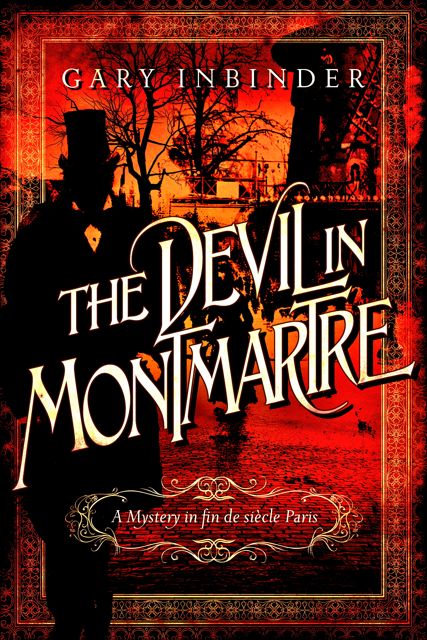Gary Inbinder, The Devil in Montmartre
reviewed by Bill Bowler

The Devil in Montmartre Publisher: Pegasus Books Length: 264 pp. ISBN: 9781605986470 |
What do Space Opera, Frankenstein, Napoleon’s invasion of Russia, American Impressionist Painting, Baron Hausmann’s Paris, Jack the Ripper, and Sherlock Holmes have in common? Gary Inbinder, of course. All of these modes, characters, themes, genres and cultural icons have a place in the evolution of Mr. Inbinder’s novelistic vision, from the early futuristic fantasy “Noble Lies” through the historical romance Flower to the Painter, and culminating in his newest work, the historical literary detective novel The Devil in Montmartre.
The strengths of The Devil in Montmartre are its richly developed characters, a fully realized and grounded historical setting in place and time, and an intriguing who-done-it plot with a brilliant detective for a protagonist. The novel is rich with historical details, and with insight provided by the narrator who commands capacious and detailed knowledge of the period and of the characters.
The story unfolds in the cafes, art studios, grand hotels and slums of late 19th-century Paris. The narrative language, characteristically for Mr. Inbinder, is clear, straightforward, and built upon an accumulation of concrete detail, for example:
Established in Montmartre near the foot of the hill, the Atelier Cormon was located in a spacious workroom with large exposed wooden beams, unpainted walls, and immense glass windows, lamps, and reflectors suspended from rafters to provide the desired lighting. High shelves stacked with white plaster casts of nymphs, Caesars, gods and goddesses, lined the unpainted walls, and there was a centrally situated dais for models. A sharply distinctive, but not unpleasant odor of linseed oil and turpentine permeated the atmosphere; several students seated themselves at easels surrounding the dais; they concentrated their attention on a dark, young woman posing nude, in a semi-reclining position.
The realistic narration is often adorned with imagery:
Electric and gaslights winked out; the raucous, riotous Moulin Rouge transformed into a mausoleum haunted by spirits of the evening past. Into this crypt waddled the charwomen, armed with brooms, buckets and mops to clean up the revelers’ rubbish.
Into this milieu, and in the detail typical of the Realist novels of the time, the author introduces characters and dialog based on portrayals of personalities from the era: artist, collector, feminist, anti-Semite, heiress, doctor, rag-picker, criminal, policeman.
The portrait gallery includes the brilliant and obsessed gynecologist and surgeon Dr. Henry Collingwood; circus perfomer and criminal henchman JoJo the clown; the formidable king of the ragpickers, Le Boudin; and other figures from the Parisian underside, straight out of Les Misérables; the genius painter Toulouse Lautrec; and most of all, Achille Lefebvre, investigator from the Sûreté, along with his family and his colleagues among the French police.
Some of the characters spill over from The Flower to the Painter, of which The Devil in Montmartre serves as something of a sequel. Marcia/Mark Brownlow, the American painter; her lover and patron, the wealthy American heiress Betsey Endicott; American expatriate novelist Arthur Wolcott; are among the characters whose story is begun in Flower to the Painter and continued in The Devil in Montmartre.
Marcia has now dropped her disguise as Mark, and is dying of “consumption” in fin de siècle Paris, where she stays with Betsey, using the last of her waning strength to visit the Moulin Rouge, the World Exposition, the studio of Toulouse Latrec and other colorful locales, in the hope of completing at least one last great painting.
The author immerses the readers in the milieu, in all its beauty, ugliness, and detail, and then propels us through the narrative by means of a violent crime and the mystery of discovering its perpetrator.
In the history of detective fiction, there are basically two prototypes for the detective. We could call them brain and brawn. There is the school of Sam Spade, Philip Marlowe, and Archie Goodwin, physically strong men who bull their way to confront the bad guy by force. And there is the school of Auguste Dupin, Sherlock Holmes and Nero Wolfe, brilliant intellects who deduce their way to the solution.
Inspector Achille Lefebvre, the hero of The Devil in Montmartre, is somewhat of a hybrid, a strong physical specimen who nonetheless applies his brilliant intellect and deductive powers to solve the case. He is also something of a James Bond in that he employs the hi-tech equipment of his time — lenses, photography, and especially, the emerging technique of finger-printing — to analyze the clues and solve the crime.
By mid-story, Achille occupies the center of the narrative. His thoughts, his career, his family life, his aspirations and doubts, his politics, and his obsession with the case — all are depicted as the story unfolds. He risks his professional position and career; he deals with competition and skepticism from his colleagues as he introduces new techniques and technology of detection; he struggles in his private life to fulfill his responsibilities to his wife, family and loved ones as the case absorbs his time and attention, and his mother-in-law challenges and undermines his marriage; and in the process of his investigation, he interacts with the myriad persons of interest connected to the crime.
Another hallmark of the genre is the nemesis, the bad guy, the criminal mastermind or psychopath, the “worthy” opponent of the investigator, such as Sherlock Holmes’s Moriarty and Nero Wolfe’s Arnold Zeck. In this respect, The Devil in Montmartre also delivers, but the author introduces a number of unexpected twists into which we shall not delve for fear of spoiling the reader’s fun.
Copyright © 2014 by Bill Bowler

